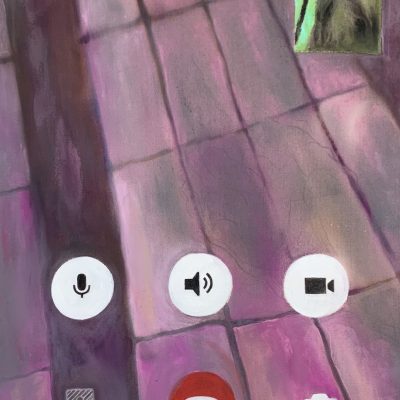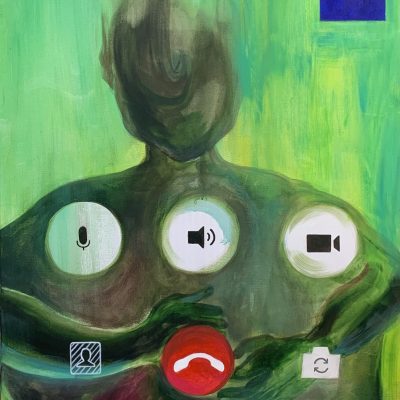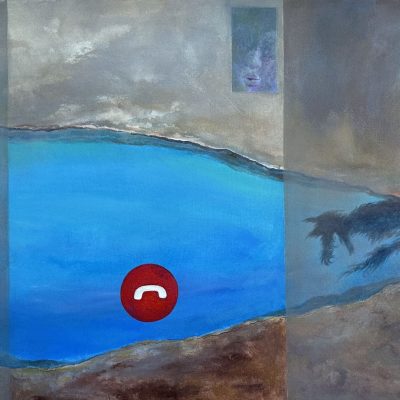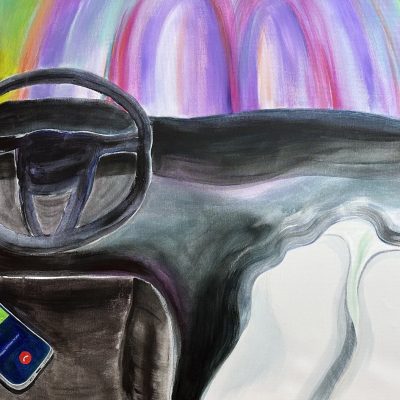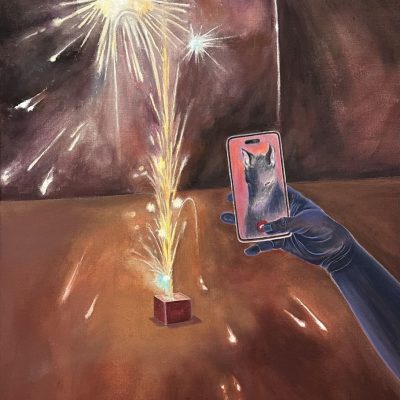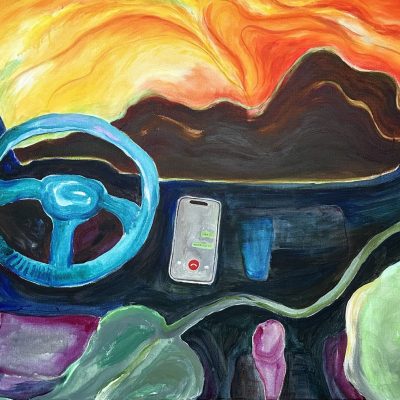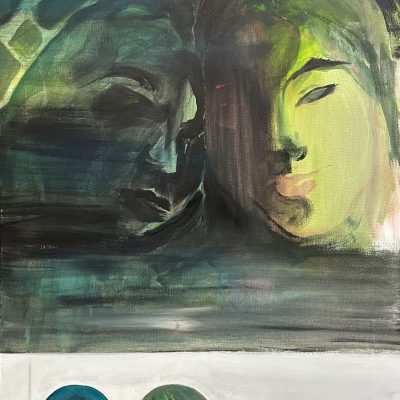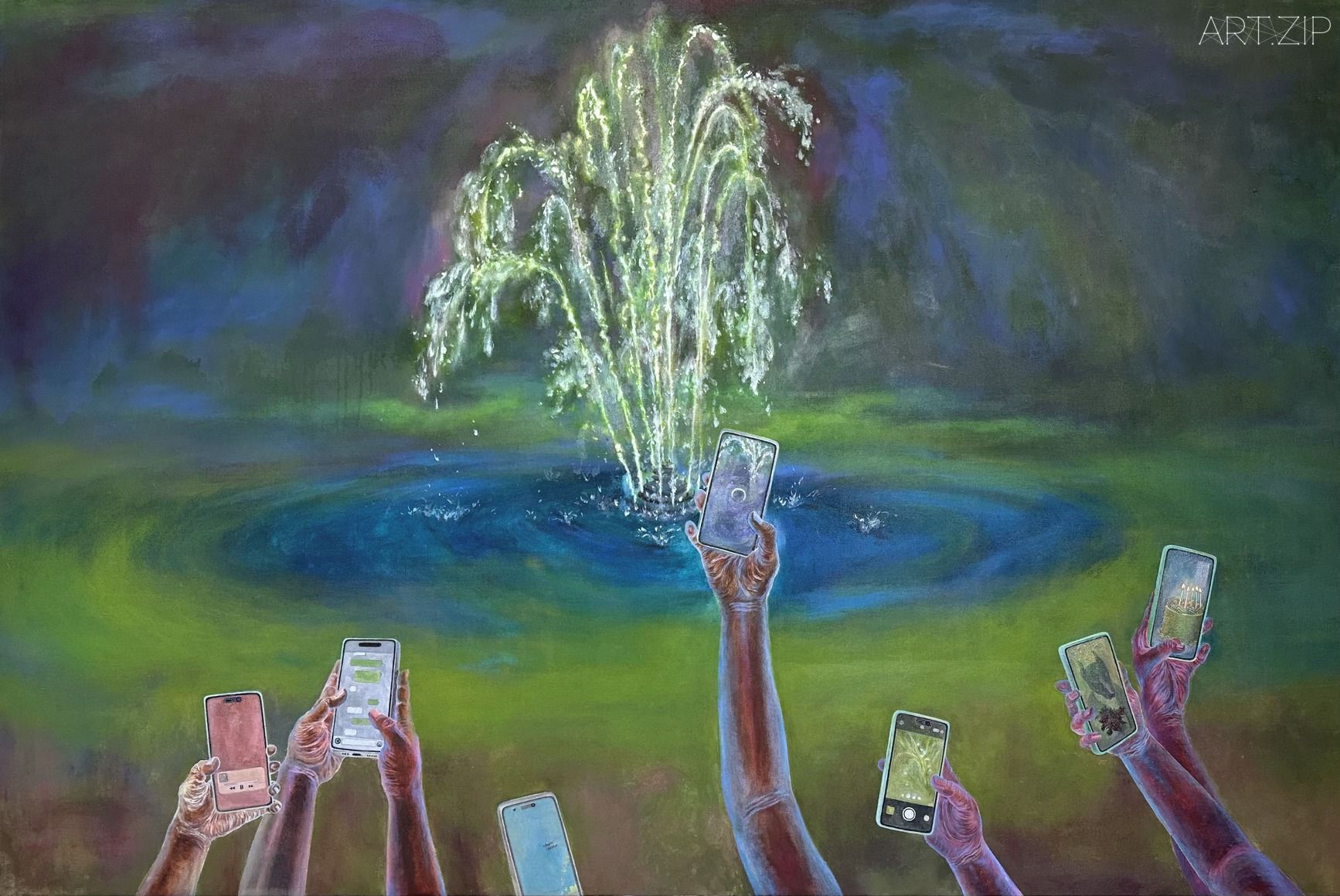
In the post-pandemic era, where digital lifestyle and remote communication have become integral parts of our lives, artist Zhengwei Li’s recent work delves into the essence of reality during this transformative period.
Within Zhengwei’s paintings, anonymous screens and enigmatic hands serve as symbolic representations of the anonymity prevalent in modern cities. Our lives have undergone profound changes in the digital age, as our memories are now stored digitally, information is transmitted seamlessly, connections are forged across time zones, and physical distances are shortened. However, this surge in digitalization has also led to a detachment from our innate connection with nature. While this user-friendly system has brought convenience, it has also caused misinterpretations, distractions, and heightened feelings of insecurity. The online world grants us access to an abundance of information, expanding our thoughts and at times exceeding the limitations of our physical existence. In Zhengwei’s paintings, screens assume the role of transforming ideas into symbols, illustrating that seemingly mundane electronic symbols and numbers, encountered daily, have acquired additional meanings and significance through human interaction and interpretation. Moreover, the digital language has inadvertently fueled misunderstandings among groups with divergent information sources.
Zhengwei’s recent works navigate the delicate interplay between sensibility and rationality in painting. These pieces explore the elusive boundaries that exist between the digital realm and reality, the interplay of control and unpredictability, the tactile sensations evoked by screens and machinery, and the intangible realities hidden behind these screens. Additionally, the artist’s paintings provoke a fundamental question: How do we experience and navigate time, space, and relationships in our contemporary world?
Through Zhengwei Li’s art, viewers are encouraged to reexamine the evolving nature of our relationship with technology and the impact it has on our perception of reality. These works beckon us to reflect upon the convergence of our digital existence with the physical world and the profound implications it holds for our experiences of time, space, and human connections.
In some of Zhengwei’s works, you can see a recurring motif emerges—the figure of a monster, an amalgamation of diverse animalistic characteristics. This figure is the artist’s sense of speculation and uncertainty about another person who is behind the screen. The audience cannot directly judge their situation, mood, and specific characteristics of this image. This figure encapsulates the prevalent themes of misunderstanding and confusion that permeate our daily experiences of virtual communication.
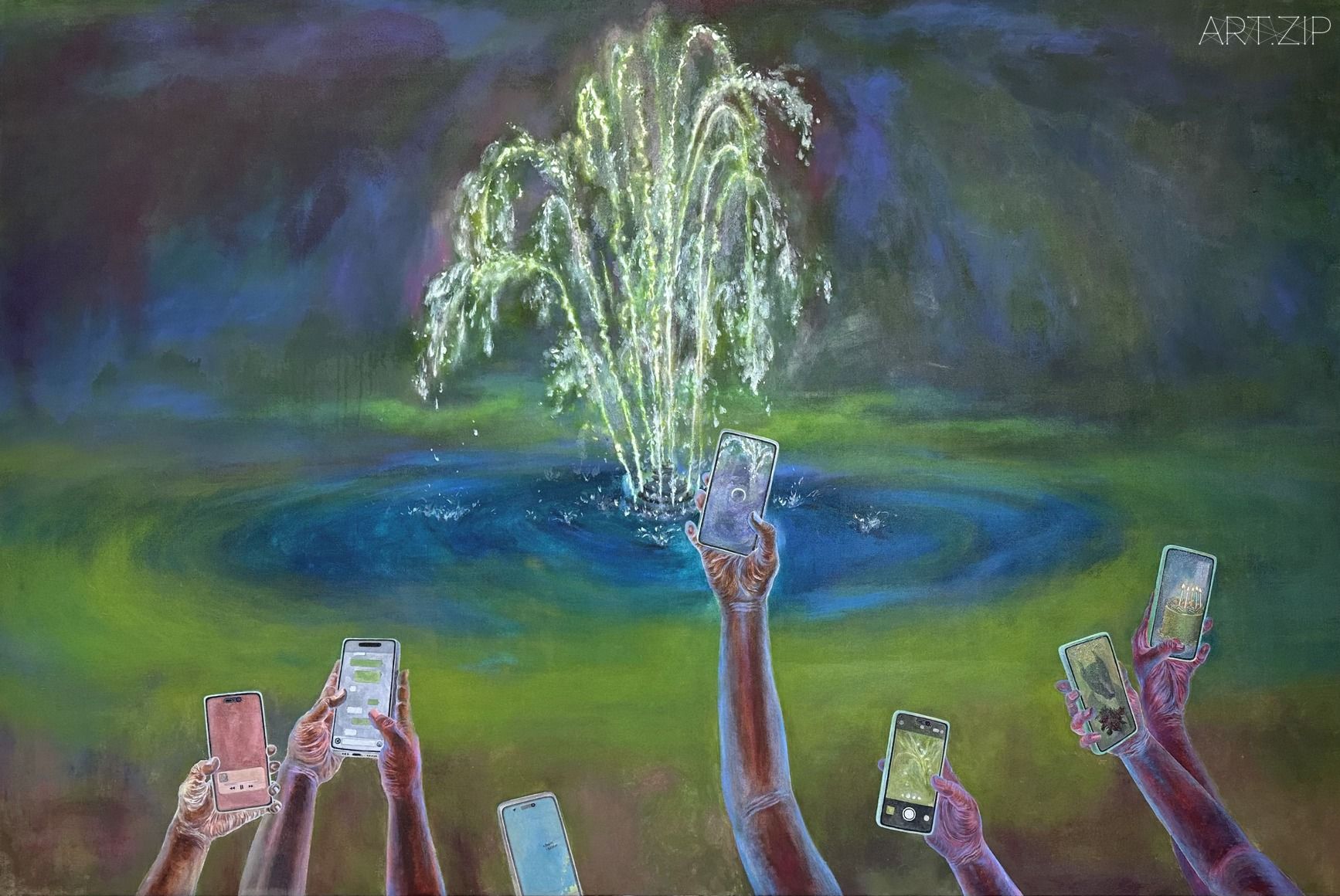
Close, Near, Far. (acrylic on canvas 布面丙烯 180 x 120cm) by Zhengwei Li
In an interview, Zhengwei discussed her creative inspiration, which comes from her trans-time-zone life and frequent video calls with family and friends. Time difference, emotional state differences, signal instability, and various technical factors make this kind of online communication full of frustration. During the pandemic, silences, confusion, and misunderstandings in online discussions sparked the artist’s contemplation of the discrepancies between the online world and real life. Zhengwei delved deeply into these emotional experiences produced online and tried to capture the essence of human connection and the challenges people face when trying to bridge the gap between the digital and physical realms through her art. As for future goals, Zhengwei expressed that organizing her own solo exhibition is something she has always wanted to accomplish. She hopes to share her artistic journey and views through the exhibition, conveying the essence of her works and providing audiences with a visually thought-provoking experience. In the long run, Zhengwei aims to delve into installation art, explore different possibilities, and express ideas through immersive exhibitions. She wants to create an interactive environment where the audience can actively participate in her work, blurring the boundaries between traditional painting and audience participation. In addition, the artist has been considering the potential of functional art, hoping to integrate aesthetics with practicality. By incorporating functionality into her creation, her goal is to strike a harmonious balance between visual aesthetics and practicality, enhance the audience’s experience, and provide a new perspective on the role of art in everyday life.
隨着後疫情時代信息化和遠程溝通在多方面覆蓋這一代人的日常生活與工作,青年藝術家李錚維的作品對此現象引發思考,質疑了人類如何在這樣的時代立足於現實。
在錚維的繪畫作品中,匿名的屏幕和一隻陌生的手代表了現代城市的匿名性。我們的生活在數字化時代發生了改變,數字設備存檔記憶、傳輸信息、使跨越不同時區的聯繫成爲可能,打破物理距離。 與此同時,它們還將人類自然的感覺被分離。 這個更容易使用的系統正在引起誤解、分散人們的注意力,並增加不安全感。線上世界使我們在人類實體中更大化地汲取信息,擴大了思想上的移動,這樣的生活方式有時甚至超越了人類原本的自然體可以理解的範疇。錚維繪畫中的屏幕將想法轉化爲符號,體現了貫穿我們日常生活的一些看似生硬和電子化的符號與數字在被使用的過程中由於人性化而延伸出了更多的含義和用法。數字語言重組後表達人類自然情感的現象日漸增多,也加大了關注不同信息的羣體之間的誤解。錚維在近期的作品中思考了繪畫中的感性與理性結合的可能性,探索數字與現實之間的微妙界限,機器的可控性與現實的不可控性,屏幕和機器帶給人的觸覺以及屏幕背後不可觸摸的現實之間的聯繫。與此同時,她的繪畫也拋出了一個對於時代的疑問:在今天,我們如何體驗時間,空間,和關係?
在錚維的一些作品中,你可以看到一個似乎融合了多種動物特徵的妖怪形象多次出現。這個形象是藝術家對於隱藏在屏幕後的人的猜測和不確定感。觀衆無法直接判斷這個形象的狀態,情緒,和具體特徵。這個形象也爲藝術家表達了我們在線上溝通經歷中的誤解和迷茫。
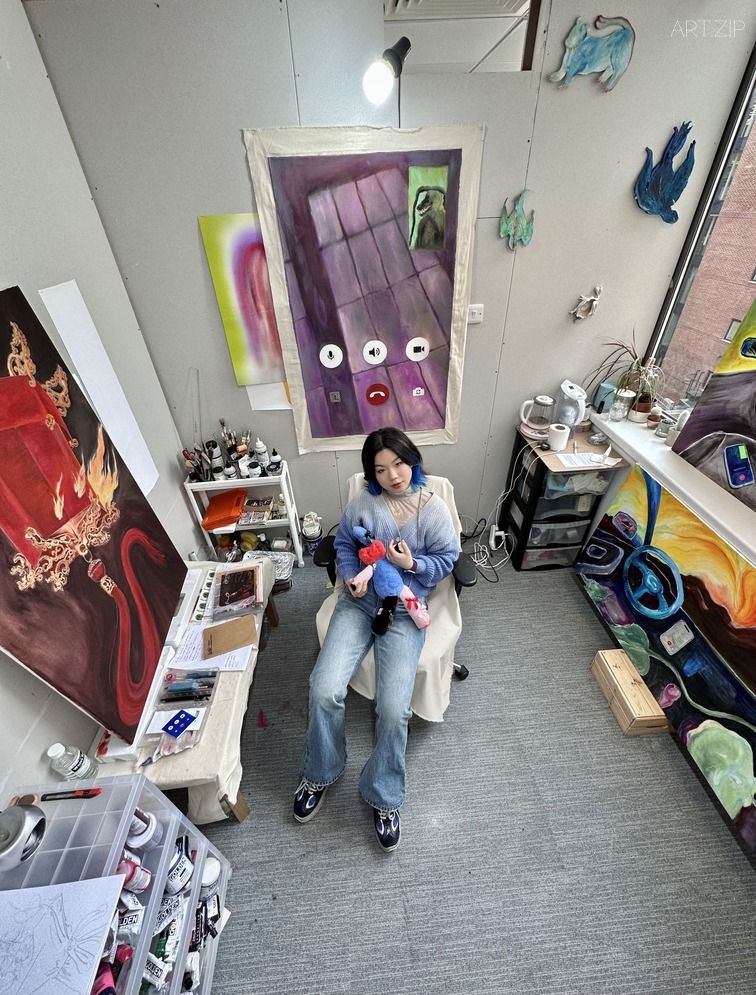
李铮维她位于伦敦塔桥的工作室 Zhengwei Li in her studio located in Tower Bridge, London
在一次訪談裡,錚維談到了她的的創作靈感,那是來自於她的跨時區生活以及常與家人朋友進行視頻通話的經驗。時差、情感狀態的差異、信號的不穩定性以及技術等多種因素,使得這種線上溝通充滿了挫折感。疫情期間的線上討論中,沉默、疑惑和誤解引發了藝術家對於線上世界與現實生活之間的誤差的思考。錚維深入探討了這些在線體驗所產生的情感和體驗,並試圖透過藝術捕捉人類聯繫的本質以及人們在彌補數字與物理領域之間差異時所面臨的挑戰。 至於未來目標,錚維表示籌辦屬於自己的個展是一直想實現的,希望通過個展分享她的藝術歷程和觀點,並傳達她的作品的精髓,給觀眾帶來深引發深思的視覺體驗。長期來看,錚維希望深入研究裝置藝術,嘗試不同的可能性,並通過沉浸式展覽來表達想法,她想要創造一種互動環境,讓觀眾能夠積極參與她的作品,模糊傳統繪畫與觀眾參與之間的界限。除此之外,藝術家也一直在思考功能藝術的可能性,希望能夠將美學與實用性融爲一體,通過將功能融入創作中,她的目標是在視覺美學和實用性之間創造和諧的平衡,增強觀眾的體驗,並提供藝術在日常生活中的新視角。
Edited 編輯 x Michelle Yu 余小悦

